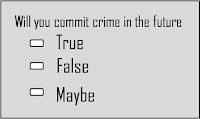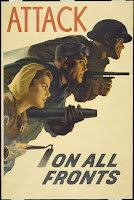To most non-economists, economics has something to do with money, and the economics of war presumably has to do with how we pay for the bombs and bullets. Economists have different and broader ideas of what their field is; my own favorite definition is that economics is that approach to understanding human behavior which starts from the assumption that individuals have objectives and tend to choose the correct way to achieve them. From this standpoint, the potential subject matter is all of the human behavior (some of my colleagues would include animal behavior as well) and the only test of whether the behavior is or is not economic is the ability of our basic assumption to explain or predict it.
Given such a broad definition of economics, one might almost say that all of warfare reduces to the technical problem of making guns that will shoot and the economic problem of getting someone to shoot them, preferably in the right direction. Board games, strategic simulations and popular articles tend to emphasize the technical problems how far a tank will shoot, what kind of armor it will go through and how many tanks (or knights or hoplites) each side has; they generally take it for granted that the playing pieces will go where they are moved. In real battles they frequently do not. The economic problem is why they do not and what can be done about it.
Economics assumes that individuals have objectives. We do not know all of the objectives that any individual has, but we do know that for most of us, staying alive is high on the list. The general commanding an army and the soldier in the front line have, in one sense, the same objectives. Both want their side to win, and both want both of them to survive the battle. The soldier, however, is likely to rank his own survival a good deal higher and the general's survival a good deal lower in importance than the general does. One consequence of that disagreement is that the general may rationally tell the soldier to do something and the soldier may rationally not do it. Neither is necessarily making a mistake; each may be correctly perceiving how to achieve his ends.
Consider a simple case. You are one of a line of men on foot with long spears; you are being charged by men on horses, also carrying spears (and swords and maces and...). You have a simple choice: you can stand and fight or you can run away. If everyone runs away, the line collapses and most of you get killed; if everyone stands, you have a good chance of stopping the charge and surviving the battle. Obviously you should stand.
It is not so obvious. I have described the consequences if everyone runs or everyone stands, but you are not everyone; all you control is whether you run or fight. If you are in a large army, your decision to run will only very slightly weaken it. If you run and everyone else fights and wins, some of them will be killed and you will not. If you run and everyone else fights and loses, at least they will slow down the attack giving you some chance of getting away. If everyone runs and you stand to fight, you will certainly be killed; if everyone runs and you run first, you at least have a chance of getting away. It follows that whatever everyone else is going to do, unless you believe that your running away will have a significant effect on who wins (unlikely with large armies), you are better off running. Everyone follows this argument, everyone runs, the line collapses, you lose the battle and most of you get killed.
The conclusion seems paradoxical; I started by assuming that people want to live and correctly choose the means of doing so and ended by predicting that people will behave in a way that gets most of them killed. But rationality is an assumption about individuals, not about groups. Each individual, in my simple example of the economics of war, is making the correct decision about how he should act in order to keep himself alive. It so happens that the correct decision for me (running away) decreases the chance of being killed for me but increases it for everyone else on my side, and similarly for everyone else's correct decision; individually, each of us is better off (given what everyone else is doing) than if he stood and fought, but we are all worse off than we would be if each of us had failed to reach the correct conclusion and we had all stood and fought.
If this still seems paradoxical to you, consider a more homely example an economic problem that occurs twice a day two blocks from where I am sitting. The scene is the intersection of Wilshire and Westwood, said to be the busiest in the world. The time is rush hour. As the light on Wilshire goes green, the traffic surges forward. As it turns yellow, a last few cars try to make it across. Since Wilshire is packed with cars, they fail and end up in the intersection, blocking the cars on Westwood, which now have a green light. Gradually the cars in the intersection make it across, allowing the traffic on Westwood to surge forward just as the light changes again, trapping another batch of cars in the intersection.
If drivers on both streets refrained from entering an intersection unless there was clearly enough room for them on the far side, the jam would not occur, traffic would flow faster and they would all get where they are going sooner which is presumably their objective. Yet each individual driver is behaving rationally. My aggressive driving on Wilshire benefits me (I may make it across before the light changes, and at worst I will get far enough into the intersection not to be blocked by cars going the other way at the next stage of the jam) and harms drivers on Westwood; your aggressive driving on Westwood benefits you and harms drivers (possibly including me) on Wilshire. The harm is much larger than the benefit, so on net we are all worse off. But I receive all of the benefit and none of the harm from the particular decision I control. I am correctly choosing the action that best achieves my objective but if we all made a mistake and drove less aggressively, we would all be better off.
I am not saying that rationality implies selfishness that is a parody of economics. Drivers may value other people's time as well as their own, or they may value a self-image that requires them to act in a polite and considerate way; if so, rational behavior (in pursuit of those goals) may prevent the jam instead of causing it. The "paradox" is not that rational behavior always leads to undesirable results it does not. In the two cases I have described, it does. What is paradoxical is that the results are undesirable in terms of precisely the same objectives (staying alive in the one case and getting home earlier in the other) that the individual behavior is correctly calculated to achieve.
Let us now return to the battlefield, replacing spears with guns. One of the less well-known facts about modern warfare is that in combat a substantial percentage of the soldiers (almost four-fifths, according to one source) do not fire their guns and those that do frequently do not aim them; this is one of the reasons that about 100,000 bullets are fired for every enemy killed. Such behavior seems irrational from the standpoint of the army soldiers are given guns in order that they may shoot the enemy with them but it may be entirely rational from the standpoint of the soldier. It is difficult to hide in a foxhole and take a carefully aimed shot at the enemy at the same time. If you can see him, he may be able to see you, and if you are taking the time to aim at him, you may be giving him, or his buddy, a chance to aim at you. If your objective is to stay alive, there is much to be said for climbing into a convenient hole and firing your gun, if at all, in the general direction of the enemy.
In discussing my first example, I pointed out that the desirability of running away depended, among other things, on how likely you thought your defection was to make your side lose the battle. The same argument applies here. At one extreme, consider a "battle" with one man on each side; hiding in a hole and firing random shots is not a sensible way of getting through it alive. At the other extreme, consider a battle with massed armies of tens of thousands of men, all shooting at each other at once. Whether you fight or hide is very unlikely to affect the outcome, so the sensible thing to do is to hide assuming, as is usually the case, that the lives of your fellow soldiers are very much less valuable to you than your own.
Many real battles represent an intermediate situation. How hard you fight is unlikely to affect who wins the battle, but it may well affect the particular part of the battle immediately around you. In such a case, the soldier must decide which of his alternatives is less likely to get him killed. The more influence he believes his actions will have on the outcome of the fight, the more likely he is to shoot instead of hiding.
I recently came across an interesting fact that fits quite neatly into this economic prediction. A study of the behavior of G.I.'s in World War II found that the soldiers most likely to fire their weapons were those carrying B.A.R.πs (Browning Automatic Rifles). A B.A.R. is a substantially more powerful weapon than an ordinary rifle; the decision to fight or hide by the man carrying it is more likely to determine what happens on his part of the battlefield and hence whether his position is overrun and he is killed than the decision to fight or hide by other members of the squad.
So far I have discussed the economic problem of war without saying anything about solutions. Obviously I am not the first person in history to realize that soldiers sometimes run away, or even the first to suggest that they do so, not because they are struck with some mysterious panic, but as a sensible response to the circumstances they find themselves in. Commanders throughout history have been confronted with the problem and have come up with a variety of ways to make it in the interest of their soldiers to fight and, if possible, in the interest of the enemy soldiers to run away.
One solution has become proverbial. You march your army across a bridge, line it up for the battle with a river (hopefully unswimmable) behind it, then burn the bridge. Since there is now nowhere to run to, much of the argument for running away disappears. Of course, if you lose the battle, you all get killed. This is called burning your bridges behind you.
Another solution is to punish soldiers who run away. One way is to have a second line of soldiers whose job is to kill any member of the first line who runs. This unfortunately ties up quite a lot of your army; if the front line all gets killed, the second line runs away, unless there is a third line to kill them for doing so. A less expensive (but also less effective) solution is to keep track of who runs away and hang them after the battle. In order for this to work, you have to have a pretty good chance of winning the battle, or at least surviving it with your command structure intact; an army that has just been routed is unlikely to have time to punish the soldiers who ran first. This suggests one reason why some commanders are so much more successful than others; once a commander has won a few battles, his soldiers expect him to win the next one. If the battle is going to be won, it is prudent not to run away and since nobody runs away, the battle is won. This is what is called a self-fulfilling prophecy. A French military theorist, Ardant du Pica, argued that the traditional picture of a charge, in which the charging column smashes into the defending line, is mythical. At some point in a real charge, either the column decides that the line is not going to run and stops, or the line decides that the column is not going to stop, and runs.
This brings me to the much-maligned British army of the eighteenth century, We all learn in elementary school about the foolish British, who dressed up their troops in bright scarlet uniforms and lined them up in rigid formations for the brave American revolutionaries to shoot at. The assumption (as in the nationalistic histories of most nations) is that we were smart and they were dumb and that explains it all. I am in no sense an expert in eighteenth-century military history, but I think I have a more plausible explanation. The British troops were armed with short-range muskets and bayonets, hence the relevant decision for them, as for the spearmen of a few centuries before, was to fight or to run. In order to make sure they fought, their commanders had to be able to see if someone was starting to run; rigid geometric formations and bright uniforms are a sensible way of doing so.
Bright uniforms serve the same purpose in another way as wellãthey make it more difficult for soldiers who run away to hide from the victorious enemy, and thus decrease the gain from running away. Of course the fugitive can always take off his uniform, assuming he has enough time (perhaps that was why they had so many buttons), but young men running around the countryside in their underwear are almost as conspicuous as soldiers in red uniforms.
Why does the range of weapons matter? With short-range weapons, the choice is fight or run; if you try to hide in a hole, someone will eventually come over and stick a spear in you. With long-range weapons, running away is hazardous, but warfare is much more likely to involve an extended exchange of fire from fixed positions, so if you hide (and enough other people on your side fight), the enemy may never get close enough to kill you.
So far all of the solutions I have discussed involve raising the cost of running away by penalizing it in one way or another. An alternative approach is to change the objectives of the fighters. If the most important thing to you is not surviving the battle but dying gloriously, the incentive to run away disappears although it may be replaced by an incentive to die gloriously in some stupid attack that loses the battle for your side.
A set of objectives that ranks glory and heroism far above mere survival is a popular theme of heroic literature and frequently appears in descriptions of exotic foreign warriors, preferably "barbarian," but it is not very common in the real world. While I have no statistics on the subject, I do have an interesting anecdote. One of the most famous of heroic warrior cultures was the Norse; the ideals of Viking warriors certainly ranked heroic death far above cowardly survival. For the operation of those ideals in the real world, I give you the following story; the source (which tells it in somewhat more detail) is Njal Saga:
Sigurd, the Jarl of the Orkneys, had a raven banner of which it was said that as long as it flew, the army would always advance, but whatever man carried it would die. At the battle of Clontarf, Sigurd led part of an army of Irish and Vikings against an Irish army commanded by the High King of Ireland. The fighting was heavy; Sigurd's forces advanced but the banner-carrier was killed. Another man took the banner; he too was killed. Sigurd told a third man to take the banner. The third man refused. Sigurd, after trying to get someone else to carry it, took the banner off the staff, tied it around his waist and led his army into battle. The army advanced, Sigurd was killed. No one would take up the banner, and the battle was lost.
So even in an army of Vikings, there were only three men (counting the Jarl) who were willing to give their lives for victory.
The desire for a hero's death is not the only objective that can keep soldiers from running away. If the soldier puts a high value on the cause he is fighting for or on the lives of his comrades, he may decide that even a small increase in the chance of losing the battle is too high a price to pay for an improved chance of his own survival. Alternatively, if the soldier puts a high value on his own reputation for courage, the shame of being seen to run away even the shame of knowing he once ran away may be sufficient to make him fight. Feelings of comradeship and an extraordinary emphasis on personal courage are sentiments traditionally associated with soldiers, and a wise commander will encourage them.
Perhaps the most famous historical example of this solution is a The ban military unit called the Sacred Band. It was said to consist of pairs of homosexual lovers. Since no man would abandon his lover or show cowardice in his presence, the Sacred Band never ran. Eventually they encountered Philip of Macedon and died to a man. This illustrates one disadvantage of courage as a solution; just as with burning your bridges behind you, the results are unpleasant when you lose.
So far I have discussed the problem from the point of view of the commander of the army that might run away. The conflict of interest between the individual soldier and the army of which he is a part is also a subject of considerable interest to the opposing commander. In playing a war game, one must actually destroy the other player's units. In fighting a war, it is sufficient to create a situation in which the members of a particular unit find it in their interest to run; having done so, one then goes on to the next unit. I conjecture that a considerable part of generalship is the ability to exploit the conflict of interest between the enemy soldiers and the army they make up.
One of my hobbies for many years has been the Society for Creative Anachronism, a group that does various medieval things for fun, including medieval hand-to-hand combat done as a rather rough sport. In order not to get anyone killed, we tend to use real armor and fake weapons; the latter are mostly made out of rattan, with reasonably realistic weight and balance but no cutting edge. The rules are supposed to define the winner as the person who would have survived the fight if both armor and weapons were real. In practice there are many difficulties, not the least being that nobody really knows how hard you have to hit chain mail with a medieval sword in order to kill the man wearing the mail.
We also do group fighting; the largest of the annual wars features armies of three or four hundred fighters on each side. The group fighting suffers from a fundamental flaw. Since being "killed" means at worst a bruise, everyone is a hero; units almost never surrender, and individual fighters never run away (except to find another fight elsewhere on the field). The battles are great fun, but considered as experimental archaeology, they are a failure; they omit one of the most essential features of real medieval battles.
There is one exception. I once participated in a melee tournament (a melee is a group fight) under rules that did, to some extent, recreate the conflict of interest between the individual and the army. The tournament consisted of a series of melees with randomly chosen teams. After each melee the fighters on the winning side received points according to their condition; an uninjured fighter received the most points, a fighter who died (but whose side won) received the fewest. At the end of the day, the fighter with the most points won. Under such a system, the fighter has an incentive to help his side win, but he also has an incentive to let someone else get killed in the front line while he bravely defends the rear. If we fought such tourneys more often, and if the winners received sufficiently valuable prizes, we might learn more about how medieval armies really worked.
This is supposed to be a book about the warfare of the future, but so far I have talked about the present and the past. My justification for doing so is that so far, at least, the economics of war in the sense in which I use the term economics has been much more stable than its technology. There has been enormous progress in weaponry over the last few millennia, but the economic problem is essentially the same, the only important change being the substitution of hiding for running as a result of the increased range of our weapons. It is possible that all this will change in the future; one can imagine a robot battlefield on which all of the problems are technical. In some respects we already have that; I presume that a soldier manning an ICBM is safer inside the silo firing the missile than running across the landscape as the warheads fall. But then, the same thing may well have been true eight hundred years ago for the soldier firing a trebuchet at a besieged castle. It remains the case now as then that a lot of soldiering involves a sharp conflict between the interest of the soldier and the interest of the soldiers, and it is likely to remain the case at least as long as the human brain continues to be a better weapons-control mechanism than anything else we can put in that small a box.








.jpg)

